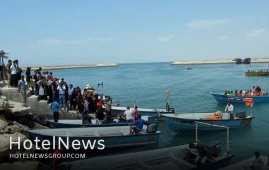
Bushehr province should invest a great deal of effort to develop its maritime tourism, the deputy tourism minister Ali-Asghar Shalbafian has said. TEHRAN - Busher province should invest a great deal of effort to develop its maritime tourism, the deputy tourism minister Ali-Asghar Shalbafian has said. “If the southwestern Bushehr province wants to develop tourism, it should focus on maritime sector,” the official said on Thursday. “The province needs to inform investors about its capacity in this sector, especially its favorable location on the Persian Gulf coast.” He made the remarks during a meeting with the provincial tourism chief Mohammad Hossein Arastuzadeh. The coastal region, ports, islands and coasts of the Persian Gulf are among Bushehr's greatest natural gifts, therefore, directing the investment capacities and enthusiastic investors to the maritime tourism sector will facilitate the growth of Bushehr as a coastal tourist destination, Shalbafian explained. For his part Arastuzadeh said that by using cruise ships and traditional Lenj boats in the region, maritime tourism has grown. Over the past couple of years, the Islamic Republic has made various efforts to exploit maritime tourism potential by developing hospitality infrastructures, diversifying sea routes, and drawing private sector investors along its vast southern coasts. Prosperous maritime tourism could help the county to meet its ambitious target of attracting 20 million annual tourists by 2025. It also keeps an eye on tourism developments in the Caspian Sea in the north. Back in February, the Ministry of Tourism and the Ministry of Transport and Urban Development signed a memorandum of understanding (MOU) to develop maritime tourism and make the best use of its potential in the southern and northern coasts of the country. Promoting the culture of using the sea as a tool to increase social vitality, development of coastal activities in the form of environmentally-friendly plans and programs, and creating the necessary grounds for cooperation and exchange of knowledge and information were also among the topics of the agreement. With over 6,000 years of history and significant monuments from the Elamite, Achaemenid, Parthian, and Sassanid eras, Bushehr is one of Iran’s most important historical centers. Besides its cultural heritage, beautiful beaches and lush palm groves make it an attractive destination for world travelers. The historical and architectural monuments of Bushehr include Islamic buildings like mosques and praying centers, mansions, old towers, castles, as well as gardens. When it comes to cultural attractions, there are many historical mounds in Bushehr including Tall-e Khandaq with Sassanid architectural style, Tall-e Marv located near an Achaemenid Palace, and Qajar era Malek al-Tojar Mansion. Qajar era Kazeruni Mansion, which has been inscribed on the World Heritage List, is another attraction that world travelers love to see among various ancient sites.
Create: Oct 16, 2021 Edit: Oct 16, 2021 Regional News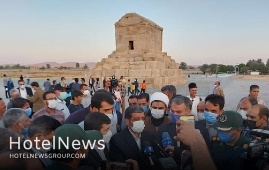
The UNESCO-registered Pasargadae is a symbol of human civilization in ancient Iran, tourism minister Ezzatollah Zarghami has announced.There is no doubt that Pasargadae belongs to Cyrus the Great, who is regarded as a legend in the world, whether or not he was buried here, it is important to respect him as an Iranian, the minister said on Thursday. He made the remarks during a visit to the majestic World Heritage site, which is situated in the southern Fars province. “Pasargadae stands out for its uniqueness on the international stage, if not as a special place, but as a symbol of civil and human development,” he noted. The tourism status of Pasargadae was among issues discussed with President Ebrahim Raisi during his current visit to Fars…., and funds have been considered for it, the minister added. He also noted that the majority of funds will be allocated to develop infrastructure and facilities, and making repairs for the public benefit, he said. There has already been an allocation of 200 billion rials ($4.7 million at the official exchange rate of 42,000 rials per dollar) to the historical site, he mentioned. Situated about 50 km north of Persepolis, Pasargadae embraces outstanding examples of the first phase of royal Achaemenid art and architecture and exceptional testimonies of Persian civilization. Cyrus was the founder of the Achaemenid Empire which at its greatest extent stretched from the Balkans to the Indus Valley, spanning 5.5 million square kilometers. The Persian king declared the world’s first charter of human rights, also known as the Cyrus Cylinder. Despite the minimal nature of the ruins, they make a good introduction to the wonders of Persepolis, some 60km to the south. Best visited en route from Yazd or Isfahan to Shiraz, most people fit them into an extended tour from Persepolis with stops at Naqsh-e Rostam and Naqsh-e Rajab.
Create: Oct 16, 2021 Edit: Oct 16, 2021 Regional News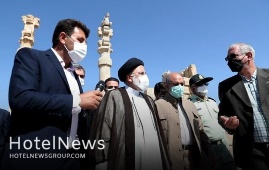
Iranian President Seyyed Ebrahim Raisi on Thursday said the UNESCO-registered Persepolis is an epitome of the great Persian art. Persepolis displays the great artistic achievements of Iranians from past millennia, which are still remarkable and admirable after so many centuries, the president said. He made the remarks during his visit to the prestigious site, which was once the ceremonial capital of the mighty Achaemenid Empire (c. 550 – 330 BC). [The ruins of] Persepolis is also conveying a message to oppressors warning them of the fate of those who are cruel to humanity, he added. The royal city of Persepolis ranks among the archaeological sites which have no equivalent, considering its unique architecture, urban planning, construction technology, and art. Persepolis, also known as Takht-e Jamshid, whose magnificent ruins rest at the foot of Kuh-e Rahmat (Mountain of Mercy) is situated 60 kilometers northeast of the city of Shiraz in Fars province. The city was burnt by Alexander the Great in 330 BC apparently as revenge to the Persians because it seems the Persian King Xerxes had burnt the Greek City of Athens around 150 years earlier. The city’s immense terrace was begun about 518 BC by Darius the Great, the Achaemenid Empire’s king. On this terrace, successive kings erected a series of architecturally stunning palatial buildings, among them the massive Apadana palace and the Throne Hall (“Hundred-Column Hall”). This 13-ha ensemble of majestic approaches, monumental stairways, throne rooms (Apadana), reception rooms, and dependencies is classified among the world’s greatest archaeological sites. Persepolis was the seat of the government of the Achaemenid Empire, though it was designed primarily to be a showplace and spectacular center for the receptions and festivals of the kings and their empire. The site is marked by a large terrace with its east side abutting the Kuh-e Rahmat (“Mount of Mercy”). The other three sides are formed by a retaining wall, varying in height with the slope of the ground from 13 to 41 feet (4 to 12 meters); on the west side, a magnificent double stair in two flights of 111 short stone steps leads to the top. On the terrace are the ruins of several colossal buildings, all constructed of a dark gray stone (often polished to a marble-like surface) from the adjacent mountain. According to Britannica, the stone was cut with the utmost precision into blocks of great size, which were laid without mortar; many of them are still in place. Especially striking are the huge columns, 13 of which still stand in the audience hall of Darius I (the Great; reigned 522–486 BC), known as the Apadana, the name given to a similar hall built by Darius at Susa. There are two more columns still standing in the entrance hall of the Gate of Xerxes, and a third has been assembled there from its broken pieces. In 1933 two sets of gold and silver plates recording in the three forms of cuneiform—ancient Persian, Elamite, and Babylonian—the boundaries of the Persian empire were discovered in the foundations of Darius’s hall of audience. Several inscriptions, cut in stone, of Darius I, Xerxes I, and Artaxerxes III indicate to which monarch the various buildings were attributed.
Create: Oct 16, 2021 Edit: Oct 16, 2021 Regional News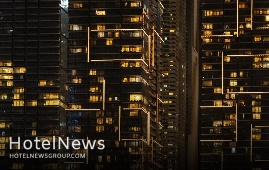
Recent weather disasters, social unrest and a heightened awareness of racial bias have prompted hoteliers to double down on their commitments to become better corporate citizens and do more to address environmental, social and governance (ESG) issues. These are moves toward a social good, sure, but also have ramifications on hotel company P&Ls. Marriott International, for one. It recently announced a commitment to reach net-zero emissions of greenhouse gases by 2050. The pledge follows the previous setting of goals by the massive global company to reduce single-use plastics, cut down on food waste by 50% and significantly amp up the diversity of suppliers, among other measures. InterContinental Hotels Group is another. Earlier this year it announced plans “to make a positive difference for our people, communities and planet over the next decade.” The company’s new commitments include a 15% “absolute reduction” of energy use and carbon emissions; a reduction of waste that will include the elimination of single-use items and a “prevent, donate, divert” plan for food waste; increased water conservation efforts; new programs to “improve the lives of 30 million people in our communities around the world” and, for employees, to “champion a diverse culture where everyone can thrive.” All of these measures benefit the public good and also have impact on a hotel’s ability to control expenses, particularly in regard to energy management. “Saving energy can—and will—impact profitability,” said Denise Naguib, VP of Sustainability and Supplier Diversity at Marriott. “For many properties, the second largest cost after labor is energy, and in some markets it actually supersedes labor, so this is a real cost that impacts the bottom line.” Energy By The Numbers Energy costs are mainly variable and there are ways to control this expense, which is of the moment now as the expense creeps back up. In U.S. hotels, the cost of electricity jumped to $4.31 in August on a per-available-room basis, compared to $3.35 in July 2020, according to HotStats data. Year-to-date August, hotels were paying $3.32 for energy, compared to $2.94 over the same period a year prior. Europe saw a similar rise, with August electricity at €6.26 compared to €8.26 in the same month last year, and €8.67 in the first eight months of this year compared to €8.26 in the same period a year ago. Small Steps, Big Rewards Operational changes large and small can help drive energy efficiency. “One of our hotels that had a high energy bill brought on an energy manager,” Naguib said. “That person found energy efficiencies and reduced the property’s energy bill by $1 million.” On a broader level, she added, properties need to empower engineers and others to find energy efficiencies, such as shutting a foyer light that’s kept on all day, deploying technology to regulate temperatures and electric usage throughout the space. Smart uses of food, such as saving the ends of vegetables for stews or making more scrambled eggs at the start of breakfast to avoid whipping up too many at the end of service, can have an impact. Energy purchasing decisions and the education of employees also can make a difference. That hands-on approach also can be used when working to make hoteliers’ purchasing choices more inclusive, Naguib said. “If any of our associates are working on RFPs or RFIs, we help them seek out diverse suppliers, such as women or minority-owned businesses. It adds more voices to the table for bidding opportunities.” Such shifts generate customer loyalty, IHG noted when it announced the company’s enhanced ESG policies.
Create: Oct 13, 2021 Edit: Oct 13, 2021 Hotel Management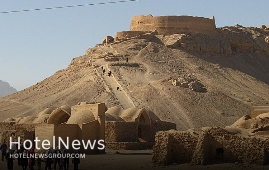
The enigmatic Zoroastrian Towers of Silence are set on two lonely, barren hilltops on the southern outskirts of Yazd in central Iran. According to a tradition dating back over 3,000 years, dead bodies were left on top of those open towers – which are also called dakhmas -- to be slowly disengaged or picked apart by desert vultures. Under ancient Zoroastrian beliefs about the purity of the Earth, dead bodies were not buried but left in these uncovered stone towers so that vultures could pick the bones clean. Narratives say that men’s corpses were placed in the outer circle, while women’s were left in the middle, and children in the inner-most ring. Bodies were then left until their bones were bleached by the elements and stripped by the vultures. After the process of purification, bones were placed in ossuaries near, or inside the towers. Ossuaries from these rituals have been discovered from the 4th and 5th centuries BC. At the foot of the hills are several other abandoned Zoroastrian buildings, including a defunct well, cistern, kitchen, and a lavatory. As Iran developed and urbanized, dakhmas became increasingly closer to city limits, severely curtailing their use. Since the 1970s, the use of dakhmas has been illegal in Iran, forcing orthodox Zoroastrians to adapt to new burial methods. According to Encyclopedia Britannica, such towers are about 25 feet (8 m) high, built of brick or stone, and contain gratings on which the corpses are exposed. After vultures have picked the bones clean, they fall into a pit below, thereby fulfilling the injunction that a corpse must not suffer contact with either fire or earth. Zoroastrian Towers of Silence are currently one of the famed travel destinations of Yazd, which is a cradle of Zoroastrianism. In July 2017, the historical texture of the city of Yazd was named a UNESCO World Heritage. Wedged between the northern Dasht-e Kavir and the southern Dasht-e Lut on a flat plain, the oasis city enjoys a very harmonious public-religious architecture that dates from different eras. With its winding lanes, a forest of badgirs (wind catchers), mud-brick houses, atmospheric alleyways, and centuries of history, Yazd is a delightful place to stay, referring to as a ‘don't miss’ destination by almost all travel associates in the region. Yazd Jameh Mosque, Dowlatabad Garden, the Yazd Atash Behram, also known as Atashkadeh-e Yazd, Towers of Silence, and adjacent desert landscape are among its tourist sites. Here is a selection of comments that visitors to the Zoroastrian Towers of Silence have posted to TripAdvisor, one of the most popular travel websites in the world: ‘Wonderful’ Should be visited to understand the ancient beliefs of Zoroastrians... This is a place where are the Zoroastrians buried their dead in the sky... (Fatih U from Izmir, Turkey) ‘Eerie’ A must site to visit if you are in Yazd to check out how the Zoroastrians dispose of their dead as they believed that after death the soulless body is impure and by burying the impure corpse in the ground, the soil becomes contaminated with impurity. (shadgerami from Nikolayevsk-on-Amur, Russia) ‘An extraordinary site’ We had planned to visit a dakhma when we toured Uzbekistan but had to give it a miss, so I was eager to visit these in Yazd. I had not realized that buildings are having a ritual function associated with the dakhma. Each family has its own building where a final funerary meal is eaten before the deceased is taken to the dakhma for excarnation. It was fascinating to walk around that part of the site before ascending the dakhma. The ascent is quite steep but aided by proper steps. Once in the main platform, there are excellent information boards in English explaining the processes undertaken. (Rod F from Royal Wootton Bassett, UK) ‘Spookily beautiful’ It is one of the most interesting sites we visited on our trip to Iran and one of the greatest reasons to add Yazd to the tour program. Totally recommended! (Muge S from Istanbul, Turkey) ‘A unique place to visit’ I can imagine how hot it must be here in the summer... we visited Yazd at Christmas time and the weather was perfect, sunny but not too hot. Climbing up to the hill makes you sweat but standing right where the corpses were left is a unique experience that catches one’s imagination. There are helpful postings in English that help you understand the context and the customs. You really can’t miss this if you visit Yazd. (Joscar00 from Stockholm, Sweden) ‘Interesting history!’ Easy walk/hike to the top. One of the towers is on a much higher level than the other. Best time to go early morning or before the sunset. (Aida B from Los Angeles) ‘Very interesting place with strong energy flow’ Don’t miss the whole story of this place as it makes it so unique and special. Going up is essential to see the whole place. Also, it gives good views around. There is very strong energy there. Going up to one of the towers is rather enough but you can choose the less popular one. This place is worth 20 min drive from the city center. (Very-sunny from Lodz, Poland) ‘A very interesting and beautiful place’ For millennia and until recently, in the 1970s, this place was used to dispose of the dead, a high priest would chop the pieces of the bodies to be fed to the birds. It is located outside the city and you can visit it on tour or by taxi. There are some temples or buildings at ground level and then you have the two hills with their sanctuaries on top. A great experience. (Etienne T. form New York) ‘Must do in Yazd’ A unique place to visit. Read a bit about the background before you come as all explanation is only in Farsi. Walk up the tower and try to imagine how the burial ceremony must have been like in those days. A must-do when in Yazd. (Isabella Deruiter form Rotterdam, the Netherlands) ‘Iconic place in Yazd with very interesting history’ This place is an essential part of the Zoroastrian religion, where the followers lay their dead loved ones' bodies at the top of the tower for the scavenging birds and weather to 'disintegrate' the bodies. The ascent to the top requires a basic level of fitness but the view of Yazd city from the top is good. I remember seeing motorbikes that bring you to the top too. (Wei T. from Singapore)
Create: Oct 13, 2021 Edit: Oct 13, 2021 Regional News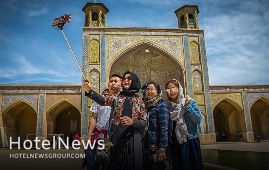
Though international tourism has revealed signs of a rebound as some destinations eased travel restrictions over the past couple of months, the lack of international coordination and slow vaccination rates in several countries and regions suggest it may need a longer time to bounce back. On the one hand, according to the latest edition of the UNWTO World Tourism Barometer, an estimated 54 million tourists crossed international borders in July 2021, down 67% from the same month in 2019, but the strongest results since April 2020. This compares to an estimated 34 million international arrivals recorded in July 2020, though well below the 164 million figure recorded in 2019. On the other hand, another research conducted by Oxford Economics on behalf of the World Travel and Tourism Council (WTTC) reveals that countries’ GDP is expected to increase only by less than one-third, as tourism is recovering even slower than expected. The research was based on the current vaccination rates globally, consumer confidence, and less stringent entry and travel restrictions in the world. However, prospects for September-December 2021 remain mixed, according to the latest UNWTO Panel of Experts survey, with 53% of respondents believing the period will be worse than expected. Only 31% of experts expect the point to better results towards the end of the year. The survey also shows that most tourism professionals continue to expect a rebound driven by unleashed pent-up demand for international travel in 2022, mostly during the second and third quarters. Almost half of all experts (45%) continue to see international tourism returning to 2019 levels in 2024 or later, while 43% point to a recovery in 2023. By regions, the largest share of experts pointing to a return to 2019 levels in 2024 or later are in Asia and the Pacific (58%). In Europe, half of the respondents indicate this could happen in 2023. West Asia is the most optimistic, with a full recovery expected by 2022. The sector needs leaders who can recognize ideas that will make a difference, who will innovate and back entrepreneurs and start-ups. As mentioned by the UNWTO Barometer, most destinations reporting data for June and July 2021 saw a moderate rebound in international arrivals compared to 2020. Nevertheless, 2021 continues to be a challenging year for global tourism, with international arrivals down 80% in January-July compared to 2019. Asia and the Pacific continued to suffer the weakest results in the period January to July, with a 95% drop in international arrivals compared to 2019. West Asia (-82%) recorded the second-largest decline, followed by Europe and Africa (both -77%). The Americas (-68%) saw a comparatively smaller decrease, with the Caribbean showing the best performance among world subregions. Meanwhile, some small islands in the Caribbean, Africa, and Asia and the Pacific, together with a few small European destinations recorded the best performance in June and July, with arrivals close to, or sometimes exceeding pre-pandemic levels.” Iran preparing for tourism rebound Iran considers reopening borders to foreign vacationers as its new tourism minister has said the government will soon scrap visa restrictions. Cultural Heritage, Tourism and Handicrafts Minister Ezzatollah Zarghami made the announcement last month following his conversations with President Seyyed Ebrahim Raisi, however, the minister did not specify the date upon which those regulations would be scrapped. According to some sources, fully vaccinated travelers would be embraced first under the updated regulations. The average of international travels to and from the Islamic Republic fell by 80 percent during the past Iranian calendar year 1399 (ended on March 20, 2021) from a year earlier. “During this period, 4,343,163 passengers entered the country, which included 3,030,464 Iranian passengers and 512,699 international travelers,” according to Arezou Ghaniun, an official with the Islamic Republic of Iran's Customs Administration. “From the beginning of 1399 to the end of it, we saw a significant reduction in passenger traffic to the country or vice versa in land, sea, rail and air borders, which were caused by various coronavirus restrictions.” Months of steep recession has taken its toll. Many travel insiders, hoteliers, and tour operators have faced big dilemmas such as bankruptcy, unemployment, debts, and the prospects of not being competitive on the international level. Panels of travel experts have mapped out new marketing strategies hoping Iran’s tourism would get back on its feet once again. For instance, the Head of the Iranian Tour Operators Association has said the international tourist flow to Iran will return to normal until 2022. Iran is potentially a booming destination for travelers seeking cultural attractions, breathtaking sceneries, and numerous UNESCO-registered sites. Under the 2025 Tourism Vision Plan, Iran aims to increase the number of tourist arrivals from 4.8 million in 2014 to 20 million in 2025. Domestic tourism as a propeller in COVID era The annual UNWTO Executive Training Programme, which was held in the Maldives from October 5 to 8, sharpened the focus on harnessing the power of domestic tourism to drive recovery and growth in destinations across Asia and the Pacific. Now in its 15th year, the event brought together representatives of 25 countries, with six (Iran, Sri Lanka, Afghanistan, Bangladesh, Mongolia, and Nepal) joining hosts in the Maldives to attend the training sessions in person. Reflecting the restart of domestic tourism ahead of international tourism, both across Asia and the Pacific and globally, the event focused on enabling destinations of all sizes to capitalize on this trend. Opening the event, UNWTO Secretary-General Zurab Pololikashvili stressed that, as tourism restarts in many parts of the world, “the sector needs leaders who can recognize ideas that will make a difference, who will innovate and back entrepreneurs and start-ups”. Confidence in travel rising sluggishly Such an enhancement was underpinned by the reopening of many destinations to international travel, mostly in Europe and the Americas. The relaxation of travel restrictions for vaccinated travelers, coupled with the progress made in the roll-out of COVID-19 vaccines, contributed to lifting consumer confidence and gradually restoring safe mobility in Europe and other parts of the world. In contrast, most destinations in Asia remain closed to non-essential travel. According to UNWTO Secretary-General Zurab Pololikashvili, there is a strong demand for international tourism, and many destinations have started welcoming visitors back safely and responsibly. However, the true restart of tourism and the benefits it brings remains on hold as inconsistent rules and regulations and uneven vaccination rates continue to affect confidence in travel,” Pololikashvili says.
Create: Oct 10, 2021 Edit: Oct 10, 2021 Regional News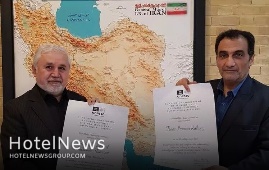
Certificates of registration of four Iranian UNESCO World Heritage sites have been handed over to the tourism ministry, the deputy tourism minister has announced. The Ministry of Cultural Heritage, Tourism, and Handicrafts has received registration certificates of four cultural heritage, which have been listed by UNESCO over the last two years, IRNA quoted Ali Darabi as saying on Friday. The ministry has received certificates for Trans-Iranian Railway, Cultural Landscape of Uramanat as tangible cultural heritages as well as the art of miniature, jointly with Azerbaijan, Turkey, and Uzbekistan and pilgrimage to St. Thaddeus jointly with Armenia, as UNESCO Intangible Cultural Heritage, the official added. Having a global register of tangible and intangible heritage is vital because these works, regardless of race, nationality, and religion, belong to all human society, and all governments and nations have a duty to preserve and protect them, even during times of war, he noted. Increased recognition of a country’s cultural heritage on the World Heritage list certainly contributes to the development of the tourism industry and businesses related to it, and most importantly, introduces the culture and civilization of a nation to the world, he explained. With 26 World Heritage Sites, Iran ranks 10th in the world in terms of the number of historical monuments and sites registered on the UNESCO World Heritage list. Before the Islamic Revolution, Persepolis, Naghsh-e Jahan Square, and Choghaznabil were the only three UNESCO-listed monuments, but today the number has been increased this number to 26 historical sites. Trans-Iranian Railway The railway can be regarded as a turning point for comprehensive developments in Iran. These developments include a wide spectrum of various economical, commercial, social, cultural, and even political aspects in a sensitive and important period of contemporary world history. Consequently, the 1394 kilometers long Trans-Iranian Railway was built with a width of 1435mm and 90 working stations along its route. It starts at a point north of Torkaman port located southeast of the Caspian Sea. After going through Sari and Qaem-Shahr cities, the railway enters the mountainous region of Alborz through the high Firooz-kooh Pass which is linked with Tehran and Varamin Plain by numerous bridges and tunnels. Further on after crossing the flatlands of Qom and Arak, the Trans-Iranian Railway penetrates Zagros highlands in Lorestan Province and passing through a large number of tunnels and bridges reaches Andimeshk situated in the low Kuzestan Plain. Finally extending to the vicinity of Dezful, Ahwaz, and its grand bridge on Karoon, the Trans-Iranian Railway is divided into two branches ending separately at Khoram-Shahr and Imam-Khomeini ports on the Persian Gulf. Cultural Landscape of Uramanat Stretched on the slopes of Sarvabad county, and shared between the provinces of Kordestan and Kermanshah, the rural area of Uramanat embraces dense and step-like rows of houses in a way that the roof of each house forms the yard of the upper one, a feature that adds to its charm and attractiveness. As the cultural landscape covers 300 villages and in terms of architecture and landscape, it is one of the most beautiful and presentable heritages in the world. Uraman is considered a cradle of Kurdish art and culture from the days of yore. Pirshalyar, which is named after a legendary local figure, is amongst time-honored celebrations and rituals that are practiced annually across the region. The art of miniature The miniature is a type of two-dimensional artwork that involves the design and creation of small paintings on books, paper-mâché, rugs, textiles, walls, ceramics, and other items using raw materials such as gold, silver, and various organic substances. Historically, the miniature was exemplified by book painting in which the text was supported visually, but the element has evolved and can also be observed in architecture and as an adornment in public spaces. The miniature displays a specific type of perspective in which the size of the figures changes according to their importance - a key difference between realistic and naturalistic styles. Though it has existed for centuries, it continues to develop and thus strengthens the bonds between past and present. Traditional painting principles and techniques are preserved, but artists also bring individual creativity into the process. Pilgrimage to the St. Thaddeus The annual three-day pilgrimage to St. Thaddeus Apostle Monastery in northwestern Iran is held each July. The pilgrimage venerates two prominent saints: St. Thaddeus, one of the first apostles preaching Christianity, and St. Santukhd, the first female Christian martyr. The bearers of the element are the Armenian population in Iran, Iranian-Armenians residing in Armenia, and followers of the Armenian Apostolic Church. Pilgrims gather in Tabriz before departing for the monastery. They cover 700 kilometers from Yerevan to the monastery annually. The commemoration ceremony includes special liturgies, processions, prayers, and fasting. It culminates in a Holy Mass with Holy Communion. Special times are set aside for traditional Armenian folk performances and Armenian dishes are served. The pilgrimage is the primary social and cultural event of the year.
Create: Oct 10, 2021 Edit: Oct 10, 2021 Regional News
Based on the planning, each Iranian province will be granted one week to showcase its capacities at Expo 2020 Dubai, according to the managing director of Iran International Exhibitions Company. Speaking during a press conference, Hassan Zamani underlined the economic, cultural, social and political significance of the Expo, saying that some 198 countries will participate in the event. Expo 2020 in Dubai runs from October 1, 2021 until March 31, 2022. Zamani said that Iran’s pavilion at the Expo will open on October 2 with the virtual presence of the Minister of Industry, Mine and Trade. Referring to Iran’s agenda at the event, he said that Iran is firstly focused on non-oil exports which are predicted to hit $100 billion and then the country will seek to observe investments for different projects. Iran has spent the least money on designing its pavilion in comparison with other participating countries, he said, however noting that the Iranian pavilion has been selected among the top eight pavilions in the event.
Create: Oct 9, 2021 Edit: Oct 9, 2021 International News
Iran is prepared to repair and restore Syrian historical monuments and tourism infrastructure that have been destroyed by the Islamic State in Iraq and Syria (ISIS), the deputy tourism minister Ali-Asghar Shalbafian has announced. He made the remarks during a meeting with the Syrian Minister of Economy and Foreign Trade Mohammad Samer al-Khalil on Sunday in the Expo 2020 Dubai. “The Iranian restorers can then exchange experiences with Syrian specialists,” the official added. He also emphasized Iran’s readiness to strengthen communication and develop tourism ties between the two countries. Health tourism and medical tourism is one of Iran's most important strengths in the tourism sector, and we welcome Syrian tourists to make use of this opportunity,” he noted. Al-Khalil for his part said that there is an increasing interest among Syrian tourists in visiting Iran, especially its northern coasts, as well as to Iranian holy cities, so the necessary grounds need to be created. The Expo 2020 Dubai opened on Thursday with a lavish ceremony of fireworks, music, and messaging about the power of global collaboration for a more sustainable future. Iran’s pavilion in the world fair is planned to showcase each Iranian province’s strengths and assets in tourism, cultural heritage, handicrafts, as well as its natural sites, traditional ceremonial practices, and historical significance. Many countries and companies are also looking to the expo - the first major global event open to visitors since the coronavirus pandemic - to boost trade and investment. According to organizers, the Expo, an exhibition of culture, technology, and architecture under the banner “Connecting Minds and Creating the Future”, is expected to be a demonstration of ingenuity, and a place where global challenges such as climate change, conflict, and economic growth can be addressed together. The Persian Gulf state has relaxed most coronavirus limitations but Expo requires face masks to be worn and for visitors over 18 to be vaccinated against, or test negative for, COVID-19. Iran expects to reap a bonanza from its numerous tourist spots such as bazaars, museums, mosques, bridges, bathhouses, madrasas, mausoleums, churches, towers, and mansions, of which 26 being inscribed on the UNESCO World Heritage list.
Create: Oct 3, 2021 Edit: Oct 9, 2021 Regional News
The star-studded opening ceremony for Dubai Expo 2020 will be streamed live to more than 430 locations across the UAE, giving everyone the chance to participate in the spectacle, wherever they might be. This will be followed a night later by three spectacular fireworks displays in Dubai, marking the first full day of the Expo in a spectacular visual celebration commemorating the journey from winning the bid in 2013 to the opening. On Thursday, nation-wide opening ceremony viewing parties will take place across the country, thanking the nation for its support and inviting everyone to come together to celebrate this momentous occasion. Screens will be set up in locations ranging from airports and shopping malls to hotels and other landmarks, relaying the incredible music and cultural performances as they happen. Among those slated to perform are world-famous tenor Andrea Bocelli; Grammy-nominated, Golden-Globe-winning actress, singer and songwriter Andra Day; platinum-selling British singer-songwriter Ellie Goulding; international mega-star pianist Lang Lang; and four-time Grammy winner Angelique Kidjo. The fireworks displays will take place on Friday evening, kicking off at 20:20, at Dubai Festival City, the Frame and the Pointe, Palm Jumeirah, with each presenting their own unique celebrations. The star-studded opening ceremony for Dubai Expo 2020 will be streamed live to more than 430 locations across the UAE, giving everyone the chance to participate in the spectacle, wherever they might be. This will be followed a night later by three spectacular fireworks displays in Dubai, marking the first full day of the Expo in a spectacular visual celebration commemorating the journey from winning the bid in 2013 to the opening. On Thursday, nation-wide opening ceremony viewing parties will take place across the country, thanking the nation for its support and inviting everyone to come together to celebrate this momentous occasion. Screens will be set up in locations ranging from airports and shopping malls to hotels and other landmarks, relaying the incredible music and cultural performances as they happen. Among those slated to perform are world-famous tenor Andrea Bocelli; Grammy-nominated, Golden-Globe-winning actress, singer and songwriter Andra Day; platinum-selling British singer-songwriter Ellie Goulding; international mega-star pianist Lang Lang; and four-time Grammy winner Angelique Kidjo. The fireworks displays will take place on Friday evening, kicking off at 20:20, at Dubai Festival City, the Frame and the Pointe, Palm Jumeirah, with each presenting their own unique celebrations. Both the Pointe and Dubai Festival City will incorporate their fountains into a dazzling light and sound show themed on Expo 2020, while The Frame façade will be lit up in Expo colours. The flags of participating countries will also be displayed at each, with booths on the ground for purchasing Expo 2020 tickets. The roster of streaming locations for the opening ceremony includes more than 240 hotels nation-wide, including Emaar’s Rove, Armani, Address Hotels & Resorts, and Vida Hotels & Resorts, as well as Accor, Marriot, Hilton, IHG, Rotana, Jumeirah, Hyatt International and Atlantis the Palm. Expo 2020 Partners are also offering their invaluable support, with many, including Dulsco, Terminus Group, L’Oreal and Nissan, hosting Opening Ceremony viewing parties for their staff. Emirates, the official airline partner of Expo 2020 Dubai, will also stream proceedings across its first and business class lounges, both local and international.
Create: Sep 30, 2021 Edit: Sep 30, 2021 International News
Visitors to the Greater Boston area have a new lodging option as Roedel Companies of Wilton, NH announced the opening of Hilton Garden Inn Boston Canton today. Hilton Garden Inn Boston Canton, conveniently located near Interstates 93 and 95 in Canton, allows easy access to Boston, Foxborough, and more, making it the perfect destination for parents of Boston college and university students, tourists exploring the city, and attendees of football games and concerts at Gillette Stadium. Hilton Garden Inn Boston Canton is only the third hotel to open in Greater Boston since 2019 and will be the first hotel in the country to exclusively serve Dunkin’ Brands coffee to guests. Hilton Garden Inn Boston Canton is also uniquely situated among prominent regional and national Massachusetts-based companies and the growing community of Canton, MA located just 18 miles south of Boston. Corporate headquarters of Boston Mutual Life Insurance, Dunkin’ Brands, and Harvard Pilgrim Tufts are all within walking distance of the hotel. The hotel is a short drive from the new Copperworks Canton Condominium community and growing Trillium Brewing Company. The hotel’s proximity to Dunkin’ Brands headquarters sparked a unique partnership as Dunkin’ Brands Coffee will be served exclusively at the hotel, a first for the Massachusetts-based coffee giant. “We look forward to the many opportunities this location will provide to guests of the Greater Boston area and beyond,” said David Roedel, Business Development Officer, Roedel Companies. “We are excited to introduce our brand to the community, to create a long-term, collaborative relationship with Dunkin’ Brands, and to be a gathering place for corporations, youth sports teams, and area residents through our dining options.” Only minutes from Blue Hills Reservation and the Blue Hills Ski Area, guests can enjoy a hike or hit the slopes locally. Proximity to the Blue Hills Country Club, Wollaston Golf Club, and other popular wedding venues offers a convenient and luxurious location for wedding parties. “Interest has been strong before our doors officially opened,” said Heidi Tessler, Director of Sales, Hilton Garden Inn Boston Canton. “We are excited to welcome several wedding parties, bridal showers, golf tournament participants and corporate meetings in July and August. Hilton Garden Inn Boston Canton boasts a 60-foot bar and open-concept restaurant. The restaurant serves breakfast and dinner. As the hotel forms a connection with the local brewers association, dining options will evolve over time to include local craft brews. Along with an open-concept lobby and restaurant, the hotel’s design pays homage to the history of Canton. Throughout the hallways and dining rooms, one will find abstract artwork that highlights the important landmarks of Canton, including Town Hall, downtown Canton and the Canton Viaduct, which, according to the American Society of Civil Engineers, is believed to be the second-oldest multiple-arch masonry viaduct in the United States. The hotel also features an indoor pool and 24-hour fitness center, complete with cardio machines and dumbbells. Large windows separate the two spaces, allowing for easy supervision if groups are split among the two spaces. The hotel features 135 guest rooms, five private dining/meeting rooms, and an event space with a large projector screen. All private dining rooms open to the courtyard where guests can enjoy cocktails around the fire pit with live music. There is one, one-bedroom suite on each floor of the four-floor hotel, perfect for bridal parties or other special occasions. Amenities in each room include a flat-screen TV, single-cup coffee maker, microwave, mini-fridge, and three-prong outlets and USB ports to charge electronics. Hilton Garden Inn Boston Canton and Roedel Companies looks forward to hosting a grand opening event in late summer or early fall to formally celebrate with the community and unveil its restaurant
Create: Jul 28, 2021 Edit: Jul 28, 2021 International News
Leading global hospitality company, Hilton, announced today the signing of three managed resorts in Mexico, furthering the company’s all-inclusive and luxury expansion plans: Hilton Vallarta Riviera All-Inclusive Resort, Hilton Tulum All-Inclusive Resort and the luxurious Conrad Tulum. The newest additions to the company’s portfolio showcase Hilton’s deep-rooted commitment to growing its unrivaled offerings in Mexico, where Hilton has more than 70 hotels open and more than 30 in the development pipeline. “Mexico has always been an incredibly important destination for Hilton. These new additions are one more symbol that tourism in Mexico is rebounding and it is with great pride that we continue evolving our offerings in this burgeoning market, especially in the luxury and all-inclusive segments,” said Danny Hughes, Executive Vice President and President, Americas, Hilton. “We are extremely proud of our new products, ongoing partnership with Parks Holdings and the resilient Team Members who are working to bring the warmth of hospitality to the new resorts entering our portfolio.” A development by Parks Hospitality and owned by Fibra UNO, Hilton Vallarta Riviera All-Inclusive Resort is expected to convert in Q4 2021. Situated between the beaches of the Bay of Banderas and the majestic Sierra Madres Mountain, the 444-room AAA Four Diamond award-winning resort features a picturesque private beach, two glistening pools, full-service spa, fitness center, six craft cocktail bars, and seven specialty restaurants offering a variety of cuisine including Asian, Italian and Mexican flavors, as well as seafood and tapas options. Catering to the evolving needs of today’s business traveler, the resort offers nearly 26,000 square feet divided with 13,000 square feet of outdoor event space and 13,000 square feet of flexible indoor meeting space. Owned and developed by Parks Hospitality, Conrad Tulum and Hilton Tulum All-Inclusive Resort are anticipated to join the Hilton portfolio in Q4 2021 and Q1 2022 respectively. The distinctly unique hotels will each provide guests with a brand-exclusive experience featuring world-class dining and extensive recreation options, while offering visitors access to shared amenities including a meetings and events complex and a state-of-art spa. “We are honored and excited to be extending our successful partnership with Hilton with these iconic resorts and bringing new unprecedented luxury options to Tulum. We believe Mexico’s unique combination of people, culture, gastronomy, and natural beauties, make it the best global destination for tourism and we look forward to our continued future growth with Hilton. I would like to thank all of Parks, FUNO and Hilton’s team for all their hard work in bringing these amazing projects to reality,” said Charles Elmann Fasja, CEO Parks Holdings. Nestled among verdant tropical vegetation, overlooking the Caribbean Sea’s turquoise waters, and situated on an expansive stretch of beach, the new-build 349-room luxurious Conrad Tulum will be Conrad Hotels & Resorts’ first hotel in Quintana Roo on the eastern coast of the Yucatan Peninsula. Located near one of the best-preserved Mayan sites in Mexico, the property will provide a secluded haven for travelers featuring a bold design aesthetic inspired by Tulum’s lush landscape, picturesque beaches, and surrounding nature reserves. In addition to elegantly appointed rooms, the new hotel’s selection of accommodations will feature contemporary and sophisticated master suites, governor suites and presidential suites. Guests can choose from seven world-class restaurants and bars featuring an array of cuisine options from Mediterranean and Asian to a special Chef Table’s dining experience and relax and unwind in five pools. Like other properties in the Conrad Hotels & Resorts portfolio, Conrad Tulum will draw on the destination’s local influence and offer a distinct experience for travelers. Travelers will enjoy an enriching escape with effortless and passionately delivered service as they explore and immerse themselves in Tulum’s culture and community. The 735-room oceanfront Hilton Tulum All-Inclusive Resort will introduce travelers to an upscale and elevated all-inclusive experience in this sought-after destination. Set to boast unrestricted views of the picturesque waters of the Caribbean Sea, the resort will offer seven dining experiences featuring international cuisine, an expansive multiple pool complex with a waterpark, and a secluded beach. In addition to the variety of dining and recreation options at the luxurious Conrad Tulum or Hilton Tulum All-Inclusive Resort, all guests at either hotel will have access to a 21,500-plus square foot spa, with 16 treatment rooms and a pool, in a private and quiet area surrounded by tropical resort grounds. Guests visiting for meetings or events will have access to a 55,000 square foot convention center and an auditorium that seats up to 400 people. Continued Growth in Mexico Hilton continues to showcase confidence in the tourism industry’s rebound, including in Mexico as seen with the recent opening of The Yucatan Resort Playa Del Carmen, Tapestry Collection by Hilton as well as the upcoming Hilton Cancun, an All-Inclusive Resort located on 100 acres of Mayan coastline with a pool complex, 12 all-inclusive culinary experiences and 715 guestrooms. With these latest additions, travelers can choose from six Hilton all-inclusive resorts in Mexico and four luxury resorts, including the renowned Waldorf Astoria Los Cabos Pedregal, the recently opened Conrad Punta de Mita, and Waldorf Astoria Cancun, debuting in 2022. The addition of these resorts reinforces Hilton’s commitment to further our all-inclusive growth strategy and expansion of our luxury resorts portfolio in the top leisure destinations in the region,” said Juan Corvinos, vice president development, Caribbean and Latin America, Hilton. “With today’s travelers planning that much-desired getaway, Hilton offers remarkable options. The announcement of these three new Hilton properties in Mexico comes on the heels of other recent all-inclusive development news: the May 2021 opening of The Yucatan Resort Playa Del Carmen, Tapestry Collection by Hilton, and the upcoming September 2021 opening of Mangrove Beach Corendon Curaçao Resort, Curio Collection by Hilton and November 2021 opening of Hilton Cancun, An All-Inclusive Resort.” Hilton currently has a portfolio of more than 170 hotels and resorts welcoming travelers in the Caribbean and Latin America, including more than 70 properties in Mexico. The company continues to pursue additional growth opportunities in the region and currently has a robust pipeline of nearly 110 hotels throughout the Caribbean and Latin America, including more than 30 projects across Mexico. Hilton Vallarta Riviera All-Inclusive Resort, Hilton Tulum All-Inclusive Resort, and Conrad Tulum will all participate in Hilton Honors, the award-winning guest-loyalty program for Hilton’s 18 distinct hotel brands. Members who book directly will have access to instant benefits, including a flexible payment slider that allows members to choose nearly any combination of points and money to book a stay, exclusive member discounts, free standard Wi-Fi and access to the Hilton Honors mobile app.
Create: Jul 17, 2021 Edit: Jul 17, 2021 International News
